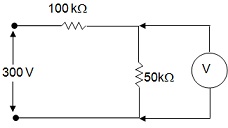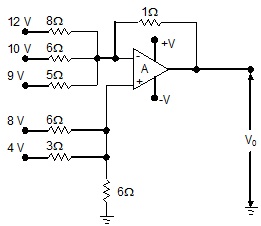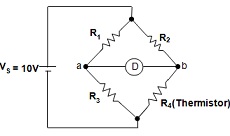Reference no: EM133047472
Revision Questions
Question 1: Consider an electric circuit having two resistors connected in series. The resistors have the following ratings:
R1 = 100 Ω±5% and R2 = 200 Ω±2%.
Determine the limiting error of the resultant resistance in:
Ohm, and
percentage.
Question 2: In a standard thermometera change in input (Temperature in °C) causes a change in its output (Resistance in Ω). Table presents the values of output when the input to the PRT is changed from 0°C to 400°C.
Table
|
Input (Temperature in °C)
|
Output (Resistance in W)
|
|
0
|
0
|
|
100
|
200
|
|
200
|
400
|
|
300
|
600
|
|
400
|
800
|
Find out the sensitivity of the thermometer.
Question 3: A temperature sensor is used to measure the boiling point of water (100.0°C). The measurement is repeated 5 times and following readings were obtained: 99.5°C, 101.2°C, 100.5°C, 100.8°C, 99.9°C. Determine the accuracy, the precision, and the bias of the thermometer.
Question 4: The dead zone in a certain pyrometer is 0.125 percent of span. Thecalibration is 400°C to 1000°C. What temperature change might occur before it is detected.
Question 5: Two pressure sensors A and B have a full-scale accuracy of ± 5%. Sensor A has a range of 0-1 bar and sensor B measures pressure between 0 and 10 bar. Which sensor is more suitable to measure a pressure reading of 0.9 bar? Illustrate your answer with reasoning.
Question 6: A temperature transducer (TT) is used to measure the temperature in a chamber that rises from 0 to 100oC. If the TT detects 10 mV/oC, describe fully why 8-bit A/D converter with a 5-V full-scale input will not be a suitable option to use?
Question 7: A 5,000Ω variable resistance potentiometer has a linearity of 0.2 % and the movement of contact arm is 360o. Determine:
(i) the maximum position deviation in degrees,and
(ii) the resistance deviation in ohm.
Question 8: It is desired to measure the voltageacross the 50 kΩ resistor in the circuit shown in Figure. Two voltmeters are available for this purpose:
Voltmeter A with a sensitivity of 100 Ω/V, and
Voltmeter B with a sensitivity of 20,000 Ω/V.
Both meters have 0-200 V range. Computethe reading of each voltmeter.

Question 9: A voltmeter having a sensitivity of 2 kΩ/V is used to measure the voltage across a circuit having an output resistance of 10 kΩ. The open circuit voltage of the circuit is 6 V. Find the reading of the voltmeter when it is set to its 10 V scale. Also, find the percentage error.
Question 10: An analog transducer with a 0-5 V input is able to distinguish a change of 5 mV in its inputsignal. Determine:
the resolution of the transducer.
the number of bits of an A/D converter so that the digital output has almost the same resolution as the transducer. The A/D converter uses a binary Code.
the quantization error, and
the number of decision levels.
Question 11: A Data Acquisition System (DAS) has 12 input channels to be sampled continuously and sequentially. The multiplexer can select and settle on a channel in 2.9μs, the Analog to Digital Converter (ADC) converts in 31μs, and the computer processes a single channel of data in 440 μs. What is the minimum time required between the samples of a particular channel?
Question 12: A physical process is described by the equation,
z=2x-3y,
where x and y are process variables. Assume that these variables are represented by voltages v1 and v2.
Design an Operational Amplifier (OPAMP) circuit that makes the quantity z as an output voltage vo. Assume voltages v1 and v2 are within the threshold value of the OPAMP.
Question 13: Design an adder circuit using an Operational Amplifier (OPAMP) to derive the output voltage Vo,expression as:
V0 = -(2 V1 + V2 + 0.2V3 ).
Where V1, V2 and V3 are the input voltages. Assume the value of the feedback resistance Rf = 1000 kΩ.
Question 14: In the circuit of Figure, find the output voltage, V0.

Question 15: A simple equal arm voltage sensitive bridge is shown in Figure. Three of its arms consist of ordinary resistors, while the fourth one has a thermistor.Initially, R1 = R2 = R3 = R4 = 1 kΩ. If the temperature change causes a +4.5 % change in thermistor resistance, what will be the output voltage indicated by the detector D?The supply voltage, Vs is 10 V.

Question 16: A uniformly wound linear resistance potentiometer is 100 mm long and has a resistance of 12 kΩ. Under normal conditions, the slider is at the centre of the potentiometer. Find the linear displacement when the resistance of the potentiometer as measured by a Wheatstone bridge for two cases is:
3000 Ω and
6000 Ω.
Also, comment on the directions of the two displacements.
In the above arrangement, the potentiometer is capable to measure a minimum value of 6Ω resistance. Find the resolution of the potentiometer in mm.
Question 17: An inductive pickup operating from a 160-tooth wheel is used with a digital frequency meter to measure the angular speed of the shaft on which the wheel is mounted. The gating period is set to 104 µs, and a reading of 0040 is obtained on the four-digit display. What speed does this represent in revolution per second (rps)? If the available gating periods are 102, 103 104, 105, 106, and 107 µs respectively, what would be the optimum setting of gating period for making this measurement?
Question 18:A resistance wire strain gauge with a gauge factor of 4 is bonded to a steel structural member subjected to a stress of 100 MN/m2. The modulus of elasticity of steel is 200 GN/m2. Calculate the percentage change in the value of the gauge resistance due to applied stress.
Question 19: The output of a Linear Variable Differential Transformer (LVDT) is connected to 5V voltmeter through an amplifier with gain of 250. An output of 250mV appears across the terminals of the LVDT, when the core moves through a distance of 0.5mm; calculate the sensitivity of LVDT and that of whole set-up. The milli-voltmeter scale has 100 divisions. Calculate the resolution in mm.
Question 20: A 41/2 digit voltmeter is used for the measurement of voltage in an instrumentation system.
Find its resolution.
How would 11.11 V be displayed on 10V range?
How would 0.5697 V be displayed on 1V range?
How would 0.5697 V be displayed on 10V range?
Question 21: A temperature transducer (TT) is used to measure the temperature in a chamber that rises from 0 to 100oC. If the TT detects 10 mV/oC, describe fully why 8-bit Analog to Digital Converter (ADC) with a 5-V full-scale input will not be a suitable option to use?